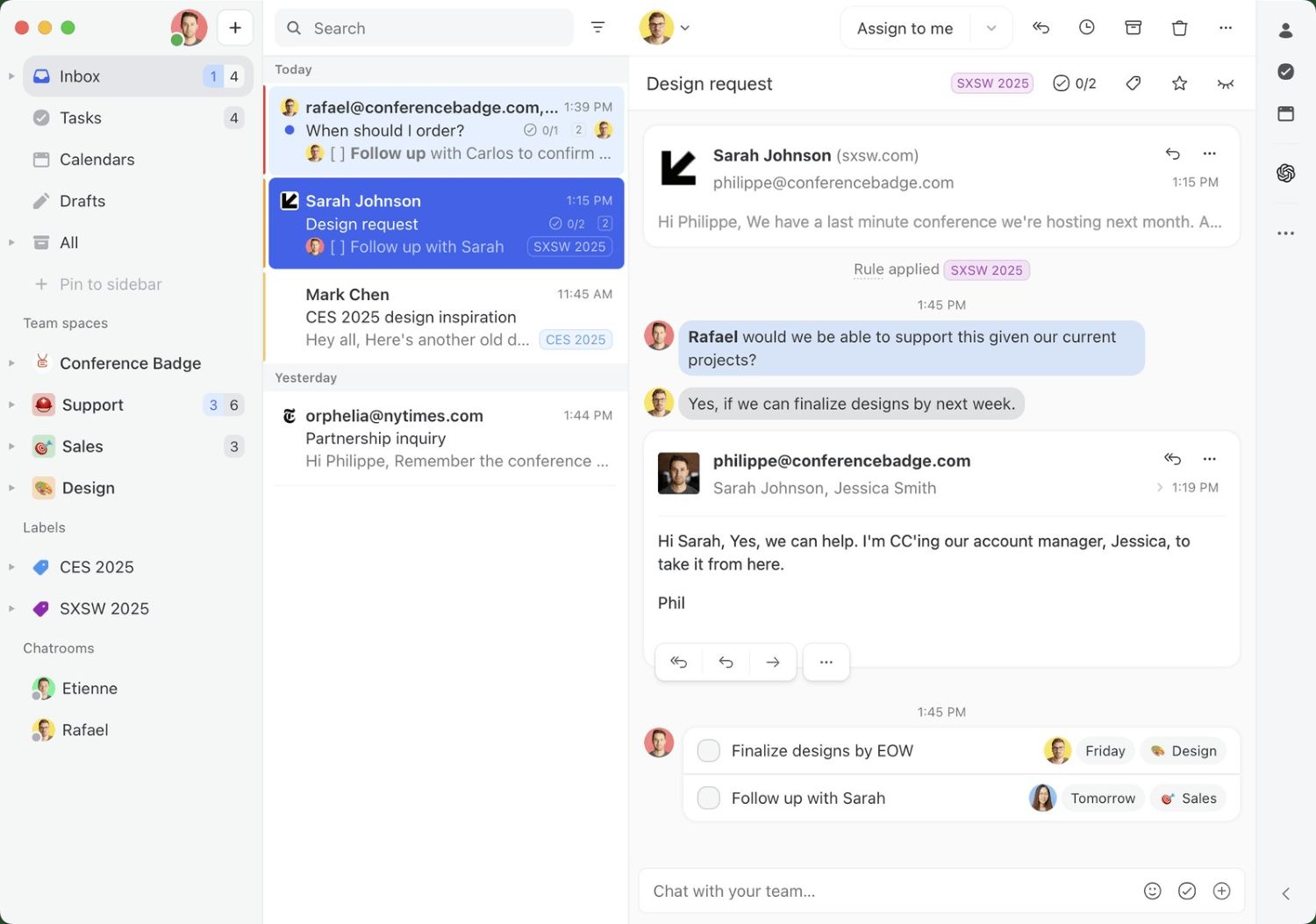By: Missive
Email wasn’t originally built for teams, but that hasn’t stopped millions of professionals and businesses from relying on it every single day. For companies where the inbox serves as the front line—think law firms, logistics, marketing agencies—Missive, a collaborative email client built in Quebec, Canada, is exploring how email could look in a more team-oriented environment. It’s working to turn the daily chaos of CCs, forwarded threads, and “just following up” messages into something more streamlined, collaborative, centralized, and manageable.
Unlike traditional email clients made for individuals like Gmail or Outlook, which were created in the time of pagers and JNCO jeans, Missive treats email as the team sport it’s become. It aims to transform the inbox into a shared, actionable workspace where communication can flow more naturally, ownership is clearer, and no message is easily overlooked. In a world where customer interactions are frequent and nuanced, this kind of shift could be helpful—and in many cases, it feels like it’s long overdue.
The Collaboration Problem Email Hasn’t Fully Addressed
Despite the seemingly endless number of digital tools and platforms available, many companies still rely on email as the backbone of both internal and external communication.
It’s a familiar scenario: A new inquiry comes in. A teammate forwards it with a quick note: “Can you take this?” or “Thoughts?” Another chimes in via Slack. Someone else adds a task to Trello, and a manager updates the CRM.
The original context—the email—ends up scattered across platforms. No one has the full picture. Eventually, someone might miss a follow-up or duplicate efforts.
This isn’t necessarily about bad habits. It’s a byproduct of tools that were never designed for what today’s teams need to be successful. Email is inherently siloed. Legacy platforms like Outlook and Gmail may have added integrations and plug-ins over the years, but the core remains largely unchanged: one person, one inbox, one thread at a time.
That’s the gap Missive aims to address. Rather than treating collaboration as an afterthought, the service integrates it into the very structure of the inbox. Team members can assign messages to one another, chat internally within the thread, track task progress, and integrate key tools—all without leaving the original message.
This seamless integration is what has led 4,000 organizations using Gmail and Outlook to switch to Missive.
When Teams Work Together, the Inbox Should Too

The goal isn’t to reinvent the wheel or, in this case, the fundamental concept of email. It’s to make the inbox align better with how teams already work. Whether you’re a law firm coordinating with clients, a freight company managing dispatch emails, or a PR agency responding to journalists, Missive helps ensure everyone has shared visibility and creates structured workflows without introducing too much extra complexity.
This design-first approach to collaboration is what sets Missive apart. It isn’t simply another app added to the SaaS stack. It becomes a central tool for communication, triage, and execution—especially for service businesses where every client interaction matters.
Built from the Inbox Out
Missive’s roots are in practicality, not buzzwords. Co-founder and CEO Philippe Lehoux spent years personally handling customer support. That front-line exposure shaped how the team approached building Missive, with a focus on the actual moments of friction people encounter daily.
Take the platform’s recent Tasks feature. It emerged directly from user feedback that real emails often include more than one actionable item. Assigning the whole thread to a single person didn’t always work. Now, with Tasks, teams can break messages down into multiple responsibilities, spanning departments, roles, or timelines—all while staying anchored to the original communication.
This focus on real-world practicality has attracted thousands of businesses, many of whom arrive after trying other, more rigid tools. Some come from Gmail or Outlook, frustrated by their lack of transparency. Others leave VC-backed inbox startups like Front after seeing prices spike or workflows become overly complex. Missive, by contrast, stays lean by design and fair by default.
Built for Small Teams, Not Just Big Ambitions
What’s especially notable about Missive is its size and philosophy. The team is small—just 14 people. It’s entirely bootstrapped. And it hasn’t aggressively pursued enterprise customers (though a handful have found it). Instead, the company has focused on serving small and mid-sized businesses: the law firms, real estate teams, marketing agencies, and regional services that power much of the economy but are often overlooked by larger SaaS brands. These businesses don’t necessarily want five new tools. They want one that works and can flex to their business needs.
Missive’s pricing model reflects this approach. It’s transparent, without hiding features behind sales calls or gated demos. It doesn’t force users into seat counts they don’t need. And it avoids the complexity creep that often arises when platforms try to be everything to everyone.
Why the Future of Work Might Start with a Smarter Inbox
If there’s a trend in software today, it’s consolidation. Teams are increasingly tired of stitching together five platforms to do the work that one should handle. And yet, many inbox tools haven’t fully caught up. The email inbox should be the source of truth. It’s where customers first reach out. It’s where decisions are documented. It’s where accountability lives. When that inbox is collaborative, flexible, and intuitive, the entire workflow is more likely to run smoothly.
Missive isn’t trying to replace email. It’s working to help it evolve. By embedding collaboration where it naturally happens—in the inbox itself—it aims to turn scattered communication into structured teamwork. It makes context easier to access, decisions easier to track, and workloads easier to manage.
For the teams that spend so much time in their inboxes, this shift could be more than an upgrade. It could be a relief.
Published by Jeremy S.









